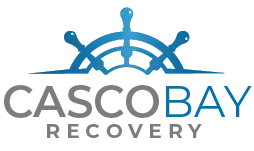At Casco Bay Recovery, we are aware of the fact that many people suffer from marijuana misuse. While this drug has been used recreationally and medicinally, it can be habit-forming. So, we provide addiction treatment and resources for those who may be struggling to overcome problematic marijuana use or other drug use problems.
What is Marijuana?
Marijuana is referred to as dried-up flowers, leaves, seeds, and stems of the Cannabis indica plant or the Cannabis sativa. The Cannabis sativa contains a mind-altering and psychoactive chemical delta-9-tetrahydrocannabinol (THC), as well as various other compounds. It contains more than 400 chemicals. The Cannabis plant material can also be concentrated in a resin as a sticky black liquid called hash oil or hashish.
Uses and Effects of Marijuana

Marijuana smoke has a distinctive and strong sweet-and-sour odor. The effects of marijuana vary depending on the individual using it, but when it’s smoked, the THC will pass through the lungs into the bloodstream swiftly. When it’s consumed as an edible product, marijuana effects will take about 30 mins to 1 hour to appear.
Another way a person can ingest the drug is to mix the plant’s flowers, stems, seeds, or leaves into food or even brew the leaves as tea. THC can affect specific parts of the brain, leading to effects such as:
- Body movement and impaired memory
- Hallucinations
- Altered senses
- Mood swings
Marijuana is produced in several different forms:
- Edibles like tea and brownies
- Cigarettes (also called joints)
- Honey oil or hash oil
- Budder or wax
- Shatter
Since marijuana comes in several different forms, individuals use marijuana in various ways. Some individuals smoke it by hand-rolling them as cigarettes or joints, and others mix the dried marijuana leaves into edible products and eat them. There is another common practice called dabbing, which can occur.
Slang Terms for Marijuana
The following terms are slang or street names for marijuana:
- Mary Jane
- Reefer
- Grass
- Weed
- Blaze
- Dope
- Pot
Statistics Regarding Marijuana Usage

According to the Drug Enforcement Administration (DEA), the rising popularity of marijuana can be attributed to its growing acceptability in today’s society. It is widely accepted as being considered “less risky” than other substances such as painkillers, alcohol, or tobacco.
According to Drug Abuse Statistics, marijuana might be considered “less harmful” since there are no marijuana-related overdoses. To paint a clearer picture, about 72% of Americans stated that regular alcohol use is a greater health risk than the regular use of marijuana.
Furthermore, approximately half of Americans, 78 million people, claimed to have used marijuana at some point in their lifetime. To take it one step further, around 17% of individuals who start using the drug as minors become addicted.
More conventional beliefs suggested that 76% of the population feel that marijuana is less harmful than tobacco. 67% believe that marijuana is less harmful than prescription painkillers.
According to the National Survey on Drug Use and Health, the percentage of individuals that engaged in marijuana use in the past year was the highest among young adults aged 18-25 (34%). This is compared with 16.3% of adults aged 26 years or older and about 10.1% of adolescents aged 12 to 17.
2019 NSDUH data suggested that 48.2 million Americans aged 12 or older, which is 17.5% of the population engaged in marijuana use in the past year. Furthermore, approximately 4.8 million individuals aged 12 or older in 2019 had a marijuana use disorder.
Signs and Symptoms of Marijuana Addiction
Marijuana addiction is one of the most commonly diagnosed during the adolescent stage or young adult. However, recent trends toward the greater socio-economic acceptance of marijuana use and the increased availability of both medicinal and recreational forms of the drug might increase the addiction rate in older adults.
With other types of drug addiction, there are physical/behavioral signs that can signal marijuana addiction (known medically as cannabis use disorder).
Behavioral Symptoms
- Engaging in reckless and risky, or otherwise dangerous behaviors
- Lack of attention to personal hygiene and appearance
- Deception or secrecy about one’s actions/whereabouts
- Difficulty in problem-solving and thinking
- Unexplained absences from work
- A decline in performance at work
- Possession of drug paraphernalia
- Engaging in eating binges
- Changes in peer group
- Impaired coordination
- Distorted perceptions
Physical Symptoms
- Red, glassy, and/or bloodshot eyes
- Constant, mucus-filled cough
- Anxiety, fear, or paranoia
- Delayed reaction time
- Impaired motor skills
- Increased appetite
- Poor coordination
- Loss of control
- Rapid heartbeat
- Poor memory
- Weight gain
- Dry mouth
- Hunger
- Fatigue
Cognitive Symptoms
- Lack of ability to concentrate or focus
- Difficulty tracking the passage of time
- Impaired sensory perception
- Poor decision-making skills
- Memory problems
- Delayed reactions
Psychosocial Symptoms
- Declined interest in issues and activities that were once of great importance
- Social isolation and withdrawal
- Panic, fear, and/or paranoia
- Irritability and agitation
Signs of Marijuana Use
The Munchies
Tetrahydrocannabinol (THC) is the most active ingredient in marijuana and it activates parts of the brain that are linked to appetite. Generally, munchies include “junk food”. If an individual has noticed a huge increase in their appetite or their rooms are filled with bags of chips, empty food pantries, refrigerators being raided, and frequent fast-food trips, this could be a sign of marijuana use.
Behavioral Changes
It’s necessary to be careful upon determining if a change in a person’s behavior is due to marijuana use. Marijuana use problems may be present if an individual no longer enjoys doing things that they once loved, shows signs of isolation or depression, and seems lethargic.
Hygiene Changes
This sign can go either way. Sometimes individuals who engage in marijuana struggle to keep a tidy appearance, wear the same outfit every day, and do not take proper care of their hygiene. On the flip side, individuals who desire to hide their drug use might use breath mints, spray cologne, and use eye drops to mask the signs of being high.
Drug Paraphernalia
Be on the lookout for bongs and pipes, which are instruments used to smoke marijuana. Tin Soda Cans can also be utilized as a pipe. Individuals will get super creative upon finding ways to smoke. A great indicator is a smell being left behind.
Is Marijuana a Gateway Drug?

Adults who reported marijuana use during the first wave of the survey were more likely than other adults who didn’t use marijuana to develop an alcohol use disorder in three years. Furthermore, individuals who engaged in marijuana use and already had an alcohol use disorder at the beginning were at greater risk of the alcohol use disorder worsening.
Therefore, marijuana is also linked to various other substance use disorders including nicotine. Early exposure to cannabinoids in adolescents decreases how reactive their brain dopamine will be later in adulthood. However, several individuals engage in marijuana use and do not go on to use “harder” substances.
Alcohol and nicotine are similar to marijuana by priming a person’s brain for a more heightened response to other drugs. They are generally used before a person progresses to more harmful substances.
Ultimately, it is vital to note that other factors besides biological mechanisms are also critical in an individual’s risk for drug use such as a person’s social environment. The alternative to the gateway hypothesis is that individuals that are more vulnerable to drugs are more likely to engage in tobacco and alcohol.
Marijuana Addiction Treatment
Here at Caso Bay, we offer a marijuana rehab for those who are struggling with marijuana addiction. Even though there isn’t a particular marijuana addiction cure, professional treatment can assist a patient in overcoming it. There are several marijuana addiction treatment options.
Outpatient Program (OP)
An outpatient program (OP) is more of a general term that addiction treatment centers utilize to describe, in this case, a marijuana rehab program that doesn’t require an overnight stay. This treatment approach enables the patient to receive high-quality care on more of a flexible schedule. Typically, there are three outpatient program options with our marijuana rehab.
- Partial hospitalization program (PHP)
- Intensive outpatient program (IOP)
- Standard outpatient program (OP)
The benefits of an outpatient program include:
- Flexibility
- Affordability (as compared to inpatient rehab)
- Comfort (Patients can continue living at home or in a stable, substance-free environment.)
Partial Hospitalization Program (PHP)
The partial hospitalization program is type of outpatient rehab program. A partial hospitalization marijuana rehab program may require patients to receive intensive treatment for approximately 5-8 hours a day, and 5-7 days a week. This type of program is beneficial because it allows patients to live in their own homes. Also, a PHP can be quite affordable and it provides clinical care to recovering individuals. While recovering, patients get to spend time around friends and family.
Intensive Outpatient Program (IOP)
An intensive outpatient program (IOP) is another type of outpatient rehab program. An intensive outpatient marijuana rehab program targets a wide range of depression and addiction disorders. Most patients that struggle with mental illness and substance abuse could benefit from attending an IOP.
One of the biggest benefits of IOPs is to offer the privilege of maintaining a daily life outside of an addiction treatment center. IOPs offer the following to patients:
- Real-life experience outside of sessions
- Increased family and friends interactions
- Assistance with job hunting
- Built-in coping mechanisms
- Transition phase
Sober Living
A sober house in Maine offers patients the recovery space to live in growth, healing, and light without the presence of drugs or alcohol. It is considered to be a substance-free and safe residence for those in addiction recovery. Generally, sober living homes are referred to as halfway homes or transitional living.
It bridges the gap between the drug rehab space and the “real world”. Sober living helps in facilitating the transition from rehab back to life. One of the main goals of sober living is to separate the individuals from their previous substance-filled environments.
By doing this, individuals are provided safe and supportive spaces to heal away from any negative outside influences. There are rules, phases, and benefits of sober living. We can help you decide if this option is right for you.
Aftercare Programs

Aftercare programs for substance abuse can provide patients with continuous assistance that can help individuals in recovery maintain their overall sobriety.
In addition, an aftercare program is any follow-up treatment for initial substance abuse that are often intensive or inpatient treatment programs. The main goals of aftercare programs are:
- Achieving a life that is filled with enriching and supportive relationships and purpose
- Maintaining long-lasting sobriety and addiction recovery
- Preventing relapses or setbacks
The benefits of aftercare programs include:
- Allowing a patient to learn futuristic strategies and valuable coping mechanisms
- Creating a support group that the patient can count on after treatment is ended
- Allowing ongoing treatment even after the main treatment has concluded
- Continuous support after the initial treatment approach
- Reduce the risk of relapse significantly
Marijuana Addiction Treatment Awaits at Casco Bay Today
Though marijuana is accepted, it has the power to cause circumstances in a person’s life. There is a variety of symptoms and signs that one must look out for if they suspect a loved one has a marijuana addiction. You’re not alone in this battle.
Here at Caso Bay Recovery, we offer a substantial amount of comprehensive marijuana addiction treatment methods that can help. Our marijuana rehab can help you learn coping mechanisms and embark on a new life. Your road to recovery awaits.
References:
https://nida.nih.gov/publications/research-reports/marijuana/marijuana-gateway-drug

